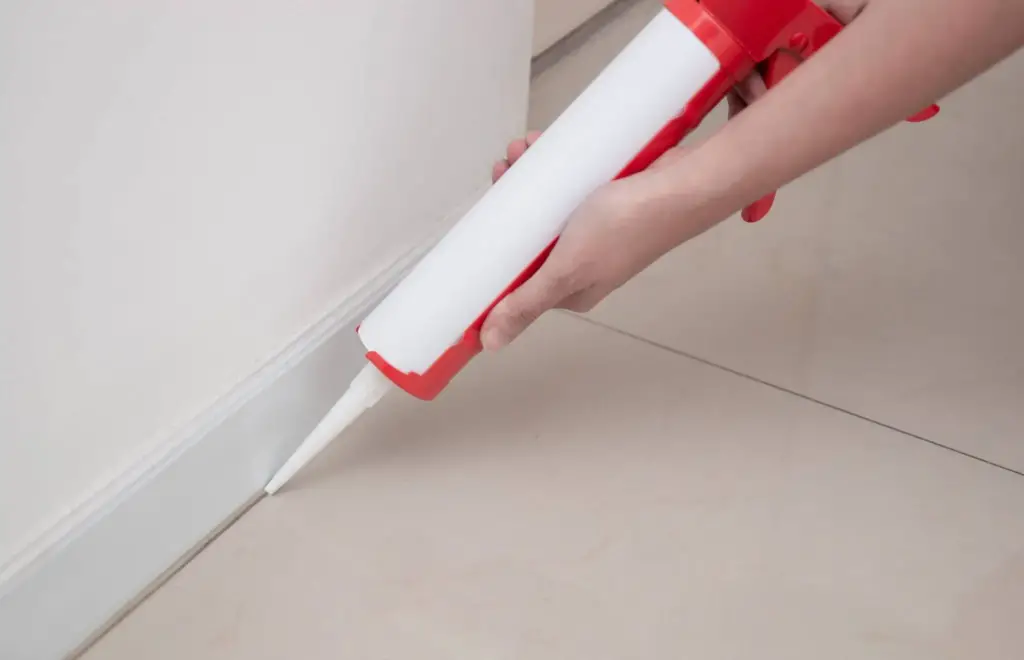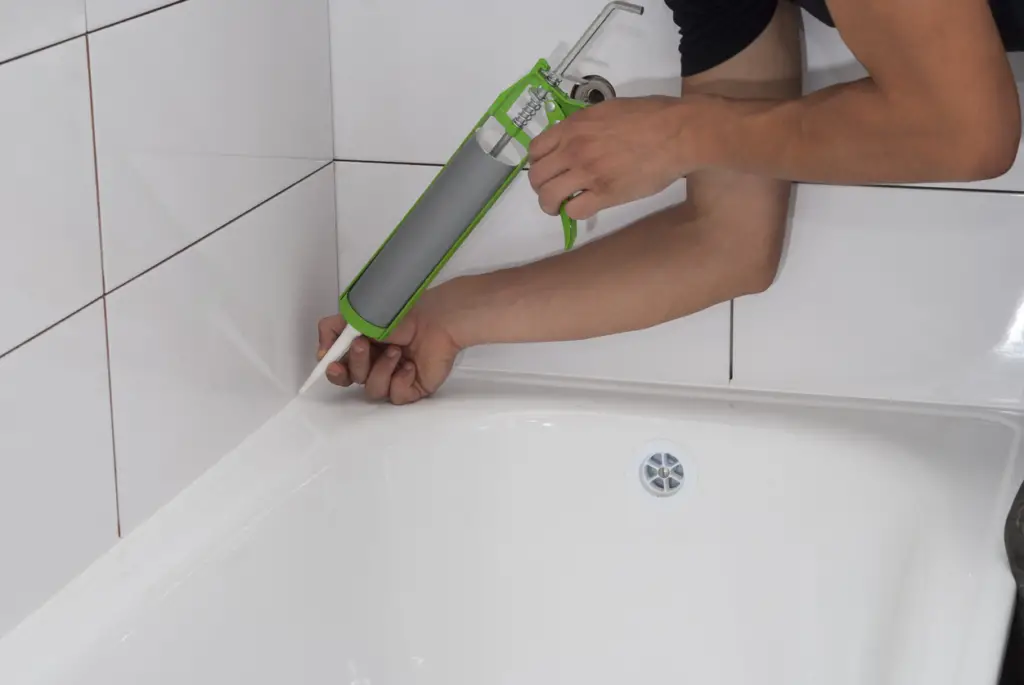Silicone caulk is a sealing or waterproofing agent with a gel-like consistency. We use silicon caulk in indoor and outdoor construction to seal off leaking joints. It is mainly used for sealing around windows and doors, plumbing fixtures such as toilets, showers, sinks, and tile joints.
The silicone caulk cannot be painted on but comes in a variety of colors that can match your interior.

How Long Does Silicone Caulk Sealant Last?
Silicone caulk is known for its durability and long lifespan, which is why it’s loved and preferred by many. Silicone caulk has a shelf life of one year after production. However, the number of years a silicone polyurethane caulk sealant will last is dependent on several factors.
Factor –1: Quality of the silicone caulk

One of the major determinants of how long a silicone polyurethane caulk sealant will last is the quality of the product. Silicone caulk products made with inferior raw materials will not stand the test of time.
When buying any silicone polyurethane re caulk product, ensure you buy from reputable companies. As some brands are much more effective than others available on the market.
Factor –2: Workmanship of silicone caulk
A silicone caulk sealant poorly applied can also affect its lifespan. Applying silicone sealants polyurethane caulk is easy, but when poorly done, can lead to problems such as unevenness, and cracks. In addition, there can be gaps between the sealant and the surface, leading to air and water leakage.
Applying new silicone caulk to old exterior caulking can also shorten its lifespan. Therefore, it is always advisable to always clear off all old caulking on the surface before applying a new coat.

Factor –3: Applies surface area
The surface needs to be prepped by cleaning off any residual bits. These bits consist of old silicone, wiping off dust, oil, and any other kinds of stains present on the surface. This is to ensure that the new silicone exterior caulk sticks well to the surface without any hindrance.
Factor –4: Quantity of silicone caulk used
Also, applying a small quantity or a thin layer of exterior caulking products is not advisable. Instead, always apply a generous amount of silicone exterior caulk to cover the entire surface because it shrinks and hardens in cold weather.
How Long Does Silicone Caulk Sealant Last Outdoors?
Silicone caulk sealant used outdoors on window and door frames can last on average between 5 and 25 years under the right conditions.
Environmental factors have a great impact on durability. For example, weather such as intense heat during the summer period, bitter cold in winter, and other weather conditions can have an impact. These effects on the exterior caulking typically impact the exterior caulking of the house.
Always perform routine checks on all your window and door frames for signs of wear and tear on the silicone caulk as it ages.
How Long Does Silicone Caulk Sealant Last Indoors?
Silicone caulk sealant is used indoors, especially in locations where water is used the most. Places such as bathrooms and kitchens can last on average between 5 and 15 years.
It is advisable to replace the caulk in your bathroom and kitchen every 5 years, even when it isn’t exhibiting any signs of aging. This will help prevent wear and tear, cracks, and even mold, which can cause damage to your plumbing fixtures.
Molding is a problem prevalent with other sealants used in bathrooms. But the silicone caulk is made with a mildewcide, which helps prevent mold as well.
Dry Vs. Wet Place: How Long Does Silicone Caulk Sealant Last
Silicone caulk lasts longer on dry surfaces compared to wet surfaces. Continuous exposure to moisture can cause mold and mildew formation.
Silicone caulk has a higher degree of resistance to molding. However, continuous exposure to moisture over a long period can still lead to molding, which in turn shortens the lifespan of the silicone caulk.
| Dry/Wet | Indoor/Outdoor | Life Expectancy |
| Dry | Indoor | 20 – 25 Years |
| Dry | Outdoor | 15 – 20 Years |
| Wet | Indoor | 10 – 15 Years |
| Wet | Outdoor | 5 – 10 Years |
Does Latex Caulk Expire?
Acrylic latex caulk is another type of caulk used for sealing gaps and holes between two or more building materials. Unlike silicone caulk, acrylic latex is water soluble. Which is very easy to apply and remove when replacement is needed, easy to correct when a mistake is made, and can also be painted on.
Acrylic Latex caulk does expire as it has a shelf life of one year when still sealed, and two months when the seal is broken. However, when used under ideal conditions, acrylic latex caulk can last for about 5 to 10 years before needing replacement.
Siliconized Latex or Silicone Caulk: Which One to Use in The Shower and Why?
The best sealant to use in your shower or any part of the house with lots of moisture is silicone caulk sealant. Here are some reasons.
- The silicone caulk is more durable, more flexible, and has more elasticity. More importantly, it has better waterproofing qualities compared to siliconized latex caulk.
- It is resistant to heat and temperature changes, water, and other moisture, and has better resistance to rot. It is rarely affected by thermal expansion, and also contains mildewcide, which helps prevent mold from forming.
- When applied correctly, silicone caulk can have a lifespan of 20 or more years.
- The downside associated with the silicone caulk sealant is that it cannot be painted on. This shouldn’t be much of an issue as it comes in different colors and also has a clear-colored version.
The siliconized latex caulk is easier to apply compared to the silicone caulk. However, it has less moisture resistance, is more likely to crack as a result of thermal expansion, and has a shorter shelf life.
Why Does Silicone Caulk Age?
Even the best-applied silicone caulk ages over time. One of the causes of aging in silicone caulk could be the result of exposure to sunlight over time.
The silicone caulk applied on doors and windows, especially on the south-facing side of the house, is prone to experiencing wear and tear. As a result of exposure to the rays of afternoon sunlight.
Changes in the climate can also cause silicone caulk to age. The constant change between the heat waves in summer is one of the reasons. In addition, the bitter cold in winter and wet weather can also have some effect on externally applied silicone caulk sealant.
Also, silicone caulk applied on dusty and dirty surfaces will age faster compared to that applied on clean surfaces. Therefore, it is always advisable to clean the surface thoroughly before applying the silicone caulk sealant.
What Are the Signs of Caulk Aging?
One of the signs of aging in silicone caulk is the presence of cracks, crumbling, and also missing pieces. Silicone caulk tends to crack, detach itself from the surface, and also drop some of its pieces when they become too old.
Another sign could be the appearance of mold or moisture around your doors and windows. Again, this is likely caused by the infiltration of water through the already weakened silicone caulk.
Another way of knowing if your silicone caulk has aged or is weak is by checking for spots. Spots along the edges of your doors and windows that allow air infiltration are one of the signs. If you move a lit candle along the edges and the flame flickers, it means the silicone caulk is leaking.
In short, here are some signs:
- Cracks
- Crumbling
- Missing Pieces
- Water leakage
Application of Silicone Caulk Sealant
Applying silicone caulk is relatively simple and easy if you follow the appropriate steps. Silicone caulk usually comes in a cylindrical tube. You will need a caulking gun or dispenser to push out the gel from its tube.
STEPS:
- Using a wet towel or rag, wipe off any dirt, oil, or dust particles on the surface where you intend to apply the silicone caulk. Dry off the surface with a clean rag.
- Using a sharp blade or knife, cut off the nozzle of the silicone sealant tube at an angle of 45 degrees.
- Use a clean rod to puncture the inner seal of the tube.
- Place the tube in the gun and adjust the trigger by gently squeezing it until it touches the base of the tube.
- Tape both sides of the surface you intend to work on, leaving a little gap in between. This will help give the silicone sealant caulk a straight line.
- Test the gun on a piece of paper or wood to ensure the silicone sealant is flowing according to your liking.
- Apply the silicone sealant caulk by squeezing gently on the trigger and moving the gun across the seam of the surface.
- Using a wet finger, spread the silicone caulk evenly. Allow the silicone sealant caulk to spread to the top of the masking tape to cover the entire surface.
- Pull off the tape, and you should have a smooth and straight-lined silicone sealant caulk on the surface.
Conclusion
Caulking is a vital process in post-construction.
The silicone sealant caulk sealant is loved for its flexibility and also its ability to cover and waterproof filler an area. It withstands ultraviolet rays. And still, allow for contractions and natural expansions.
Silicone caulk may have a long lifespan, but always check for faults from time to time and recaulk if you notice any.
Hello! this is John Cox. If I’m not wrong, you love Home. Right? And you already met one of them who’ve been in this field since 2005 and still go on. According to my interest, I’ve started this blog to share my thoughts about Home sectors, and you’ll love it.

